And thus the term “black gang.”105 years ago (Feb 1918) and here is a photo of the USS New York (BB 34) coaling at sea. The collier just dumps the coal on the battleship's deck and from then on it's back-breaking work to shovel the coal into wheelbarrows and presumably dump the wheelbarrows into chutes leading to the bunkers. And the sailors are in whites. You can imagine that coal dust was everywhere. View attachment 38871
-
Please take a moment and update your account profile. If you have an updated account profile with basic information on why you are on Air Warriors it will help other people respond to your posts. How do you update your profile you ask?
Go here:
Edit Account Details and Profile
You are using an out of date browser. It may not display this or other websites correctly.
You should upgrade or use an alternative browser.
You should upgrade or use an alternative browser.
Ship Photo of the Day
- Thread starter Randy Daytona
- Start date
Tough job - one of the reasons oil fired ships could maintain higher speeds for longer times than coal fired ships was that the stokers themselves would eventually become exhausted.105 years ago (Feb 1918) and here is a photo of the USS New York (BB 34) coaling at sea. The collier just dumps the coal on the battleship's deck and from then on it's back-breaking work to shovel the coal into wheelbarrows and presumably dump the wheelbarrows into chutes leading to the bunkers. And the sailors are in whites. You can imagine that coal dust was everywhere. View attachment 38871
As to USS New York (BB-34), some great shots from the WW2 victory parade in New York.

Searchlights aboard the aircraft carrier Enterprise (CV-6); and battleships Missouri (BB-63) and New York (BB-34) provide fans of light from their berths in the Hudson River as the biggest Navy Day celebration in NY history commences, New York, New York, 26 October 1945.
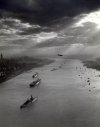
"On Navy Day in 1945, a seven-mile line of U.S. Navy warships anchored in the Hudson River and some 1,200 Navy planes flew overhead in commemoration of the event."
Tugboats and U.S. Navy warships pictured in the Hudson River with the New York City skyline in the background on the occasion of Navy Day on 27 October 1945. Visible in the foreground are the anchored heavy cruisers Augusta (CA 31), Helena (CA-75), and Macon (CA-132); carriers Midway (CVB-41) and Enterprise (CV-6); and battleships Missouri (BB-63) and New York (BB-34)
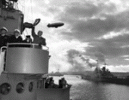
President Harry S Truman waves from the Missouri (BB-63). The New York (BB-34) is in the background and off the bow.
Fantastic picture but I think the locator is mistaken. There is no turn like that in the Hudson. That’s the East River looking north. You can the Empire State on the left and that’s the Brooklyn Navy Yard on the right. The big foundry is still there.Tough job - one of the reasons oil fired ships could maintain higher speeds for longer times than coal fired ships was that the stokers themselves would eventually become exhausted.
As to USS New York (BB-34), some great shots from the WW2 victory parade in New York.
View attachment 38876
Searchlights aboard the aircraft carrier Enterprise (CV-6); and battleships Missouri (BB-63) and New York (BB-34) provide fans of light from their berths in the Hudson River as the biggest Navy Day celebration in NY history commences, New York, New York, 26 October 1945.
View attachment 38877
"On Navy Day in 1945, a seven-mile line of U.S. Navy warships anchored in the Hudson River and some 1,200 Navy planes flew overhead in commemoration of the event."
Tugboats and U.S. Navy warships pictured in the Hudson River with the New York City skyline in the background on the occasion of Navy Day on 27 October 1945. Visible in the foreground are the anchored heavy cruisers Augusta (CA 31), Helena (CA-75), and Macon (CA-132); carriers Midway (CVB-41) and Enterprise (CV-6); and battleships Missouri (BB-63) and New York (BB-34)
View attachment 38878
President Harry S Truman waves from the Missouri (BB-63). The New York (BB-34) is in the background and off the bow.
At Jutland, she was part of the 5th Battle Squadron. An early hit to her steering led her to make 2 complete circles in front of the Kaiser’s High Seas fleet, taking 15 major caliber hits - to which Warspite seemed to reply, “What else have you got?”
IIRC that damage affected her for the rest of her career.
A detailed video from Drachinifel on the USS Franklin that I thought some may be interested in: (in particular the last 5 minutes on how the captain tried to court martial everyone who jumped off the burning ship)Received the Time Life 1978 black and white TV series World War 2: GI Diary for Christmas. One of the 25 episodes was dedicated to Big Ben, the USS Franklin. An Essex class carrier, it was hit on 2 separate occasions: by a kamikaze in 1944 and a dive bomber with two 550 lb bombs while 30+ aircraft were armed and fueled on the deck (the 2nd coming in March 1945 only 50 miles from the Japanese mainland.) Big Ben had the greatest loss of life of any US ship that did not sink in WW2, over 800 killed in action.
(Historical Note: one of the squadrons aboard the Franklin was VMF-214, the famed Black Sheep once led by Pappy Boyington)
View attachment 21259
Belleau Wood (left) and Franklin hit by kamikazes, 30 October 1944
View attachment 21256
The burning Franklin with USS Santa Fe (CL-60) alongside.
View attachment 21257
Franklin listing, with crew on deck, 19 March 1945.
View attachment 21258
Aft 5-inch gun turret on fire, 19 March 1945.
View attachment 21260
There is a video on Amazon Prime which I hope to get to this weekend.
https://www.amazon.com/USS-Franklin...K554/ref=sr_1_1?ie=UTF8&qid=1323620986&sr=8-1
https://archive.org/details/gov.archives.arc.13189
In 1990, the last U.S. Navy Diesel-electric submarine, the USS Blueback (SS 581) was decommissioned after 30+ years of service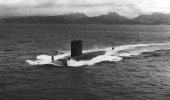 This was the passing of an era as the submarine force became all nuclear-powered. The Blueback is preserved as a museum ship in Portland, Oregon.
This was the passing of an era as the submarine force became all nuclear-powered. The Blueback is preserved as a museum ship in Portland, Oregon.
The three boats of the Barbel class were built with folding bow planes forward and later refitted with planes on the sail. This photo depicts the earlier configuration.
Diesel boat sailors were a proud, almost defiant group. The Diesel Boats Forever breast insignia was unofficial and unauthorized, but worn with pride by many.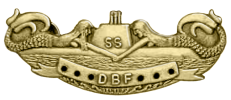
 This was the passing of an era as the submarine force became all nuclear-powered. The Blueback is preserved as a museum ship in Portland, Oregon.
This was the passing of an era as the submarine force became all nuclear-powered. The Blueback is preserved as a museum ship in Portland, Oregon.The three boats of the Barbel class were built with folding bow planes forward and later refitted with planes on the sail. This photo depicts the earlier configuration.
Diesel boat sailors were a proud, almost defiant group. The Diesel Boats Forever breast insignia was unofficial and unauthorized, but worn with pride by many.

How quiet would a 1990s diesel boat have been in comparison to a 1990s nuclear boat?In 1990, the last U.S. Navy Diesel-electric submarine, the USS Blueback (SS 581) was decommissioned after 30+ years of serviceView attachment 38907This was the passing of an era as the submarine force became all nuclear-powered. The Blueback is preserved as a museum ship in Portland, Oregon.
The three boats of the Barbel class were built with folding bow planes forward and later refitted with planes on the sail. This photo depicts the earlier configuration.
Diesel boat sailors were a proud, almost defiant group. The Diesel Boats Forever breast insignia was unofficial and unauthorized, but worn with pride by many.
I'm certainly no expert, but I think a modern Diesel-electric boat in electric mode is probably quieter. (I can't really speak to the 1990s.) The problem is that you've only got a limited endurance (a few days at low speed) in electric mode and then you need to start the noisy Diesel -- either on the surface or with a snorkel at periscope depth. The current really advanced (German etc.) non-nuclear boats have another option: Air-independent propulsion which allows more submerged time with very low noise.How quiet would a 1990s diesel boat have been in comparison to a 1990s nuclear boat?
Any really intelligent discussion of submarine quieting no doubt quickly gets into sticky OPSEC territory.
There was an article in the WSJ a few days ago stating that due to both the retirement schedule for our submarines and the lack of industrial base to accelerate procurement of new nuclear submarines, the US Navy should consider purchasing new diesel electric submarines from Japan and/or South Korea. (If you do not have a subscription to the WSJ, this article is also on Apple News)I'm certainly no expert, but I think a modern Diesel-electric boat in electric mode is probably quieter. (I can't really speak to the 1990s.) The problem is that you've only got a limited endurance (a few days at low speed) in electric mode and then you need to start the noisy Diesel -- either on the surface or with a snorkel at periscope depth. The current really advanced (German etc.) non-nuclear boats have another option: Air-independent propulsion which allows more submerged time with very low noise.
Any really intelligent discussion of submarine quieting no doubt quickly gets into sticky OPSEC territory.
Opinion | The Sorry State of America’s Submarine Fleet
To preserve its undersea advantage over China, the Navy should procure subs from Japan and South Korea.
Japan’s newest class of submarines as of 2022 is the Taigei class with the same X tail and lithium ion batteries.

Taigei-class submarine - Wikipedia
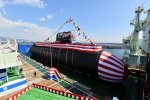
JS Taigei
I was hoping to avoid OPSEC concerns by limiting the discussion to 30-year old boats, but point well taken. AIP is fascinating stuff.I'm certainly no expert, but I think a modern Diesel-electric boat in electric mode is probably quieter. (I can't really speak to the 1990s.) The problem is that you've only got a limited endurance (a few days at low speed) in electric mode and then you need to start the noisy Diesel -- either on the surface or with a snorkel at periscope depth. The current really advanced (German etc.) non-nuclear boats have another option: Air-independent propulsion which allows more submerged time with very low noise.
Any really intelligent discussion of submarine quieting no doubt quickly gets into sticky OPSEC territory.
The procurement of some non-nuclear boats makes perfect sense to me. At least for EastPac (as Chinese SSNs get bolder) and WestLant ops to de-louse deploying USN units. I'm afraid procurement will never survive the Naval Reactors mafia.There was an article in the WSJ a few days ago stating that due to both the retirement schedule for our submarines and the lack of industrial base to accelerate procurement of new nuclear submarines, the US Navy should consider purchasing new diesel electric submarines from Japan and/or South Korea. (If you do not have a subscription to the WSJ, this article is also on Apple News)

Opinion | The Sorry State of America’s Submarine Fleet
To preserve its undersea advantage over China, the Navy should procure subs from Japan and South Korea.www.wsj.com
Japan’s newest class of submarines as of 2022 is the Taigei class with the same X tail and lithium ion batteries.

Taigei-class submarine - Wikipedia
en.m.wikipedia.org
View attachment 38913
JS Taigei
Some of the newer "Diesel-electric" boats are pretty damn impressive.
Last edited:
Did they say why they only limited it to Korean or Japanese diesel boats (I don't have a WSJ or Apple subscription)? The Germans produce some excellent boats that are world class and extremely capable. I would assume with our need to operate alongside NATO, it would be easier to get parts from them (They sell boats to other nations as well as allow for license builds) than it would to buy one-offs from Korea or Japan.There was an article in the WSJ a few days ago stating that due to both the retirement schedule for our submarines and the lack of industrial base to accelerate procurement of new nuclear submarines, the US Navy should consider purchasing new diesel electric submarines from Japan and/or South Korea. (If you do not have a subscription to the WSJ, this article is also on Apple News)

Opinion | The Sorry State of America’s Submarine Fleet
To preserve its undersea advantage over China, the Navy should procure subs from Japan and South Korea.www.wsj.com
Japan’s newest class of submarines as of 2022 is the Taigei class with the same X tail and lithium ion batteries.

Taigei-class submarine - Wikipedia
en.m.wikipedia.org
View attachment 38913
JS Taigei
The entirety of the ASW realm is heavily classified and asking about sound signatures is a no-no. Even those 30 year old Los Angeles Class subs are still classified, especially the ones still in service. Heck, our Boomer fleet is older than most 688i nuke boats and they are classified to the gills. Even as an ASW officer on board a surface ship, when we did exercises against American subs we weren't allowed to know what their sound signature was (We did, but that's a different story) and had to have an acoustic intelligence specialist from ONI ride the ship and evaluate the acoustic display every time we thought we found it.I was hoping to avoid OPSEC concerns by limiting the discussion to 30-year old boats, but point well taken. AIP is fascinating stuff.
USS Hyundai and USS Subaru? It could work.There was an article in the WSJ a few days ago stating that due to both the retirement schedule for our submarines and the lack of industrial base to accelerate procurement of new nuclear submarines, the US Navy should consider purchasing new diesel electric submarines from Japan and/or South Korea. (If you do not have a subscription to the WSJ, this article is also on Apple News)

Opinion | The Sorry State of America’s Submarine Fleet
To preserve its undersea advantage over China, the Navy should procure subs from Japan and South Korea.www.wsj.com
Japan’s newest class of submarines as of 2022 is the Taigei class with the same X tail and lithium ion batteries.

Taigei-class submarine - Wikipedia
en.m.wikipedia.org
View attachment 38913
JS Taigei
There was an article in the WSJ a few days ago stating that due to both the retirement schedule for our submarines and the lack of industrial base to accelerate procurement of new nuclear submarines, the US Navy should consider purchasing new diesel electric submarines from Japan and/or South Korea. (If you do not have a subscription to the WSJ, this article is also on Apple News)
The procurement of some non-nuclear boats makes perfect sense to me. At least for EastPac (as Chinese SSNs get bolder) and WestLant ops to de-louse deploying USN units. I'm afraid procurement will never survive the Naval Reactors mafia.
Some of the newer "Diesel-electric" boats are pretty damn impressive.
This is brought up here periodically, in addition to publications like the WSJ, and it really isn't worth it to the US Navy to make the investment. Diesel boats have some serious limitations that folks seem to gloss over and are quite disadvantageous to the US Navy in particular. Additionally there is the additional training and sustainment piece that would eat much of the supposed savings that we would get from the 'cheaper' subs.
WSJ article can be freely accessed here: gift linkDid they say why they only limited it to Korean or Japanese diesel boats (I don't have a WSJ or Apple subscription)? The Germans produce some excellent boats that are world class and extremely capable. I would assume with our need to operate alongside NATO, it would be easier to get parts from them (They sell boats to other nations as well as allow for license builds) than it would to buy one-offs from Korea or Japan.
